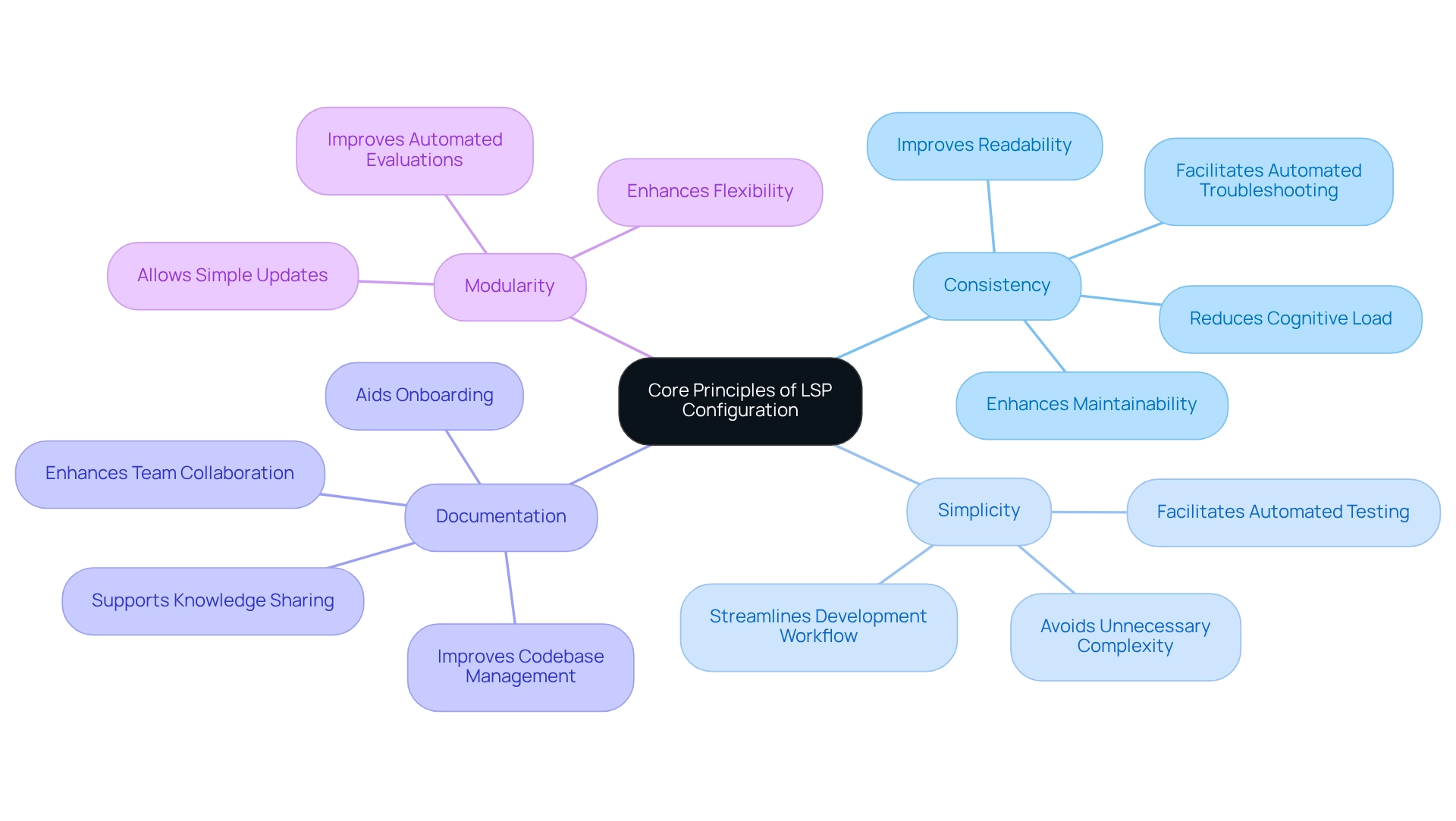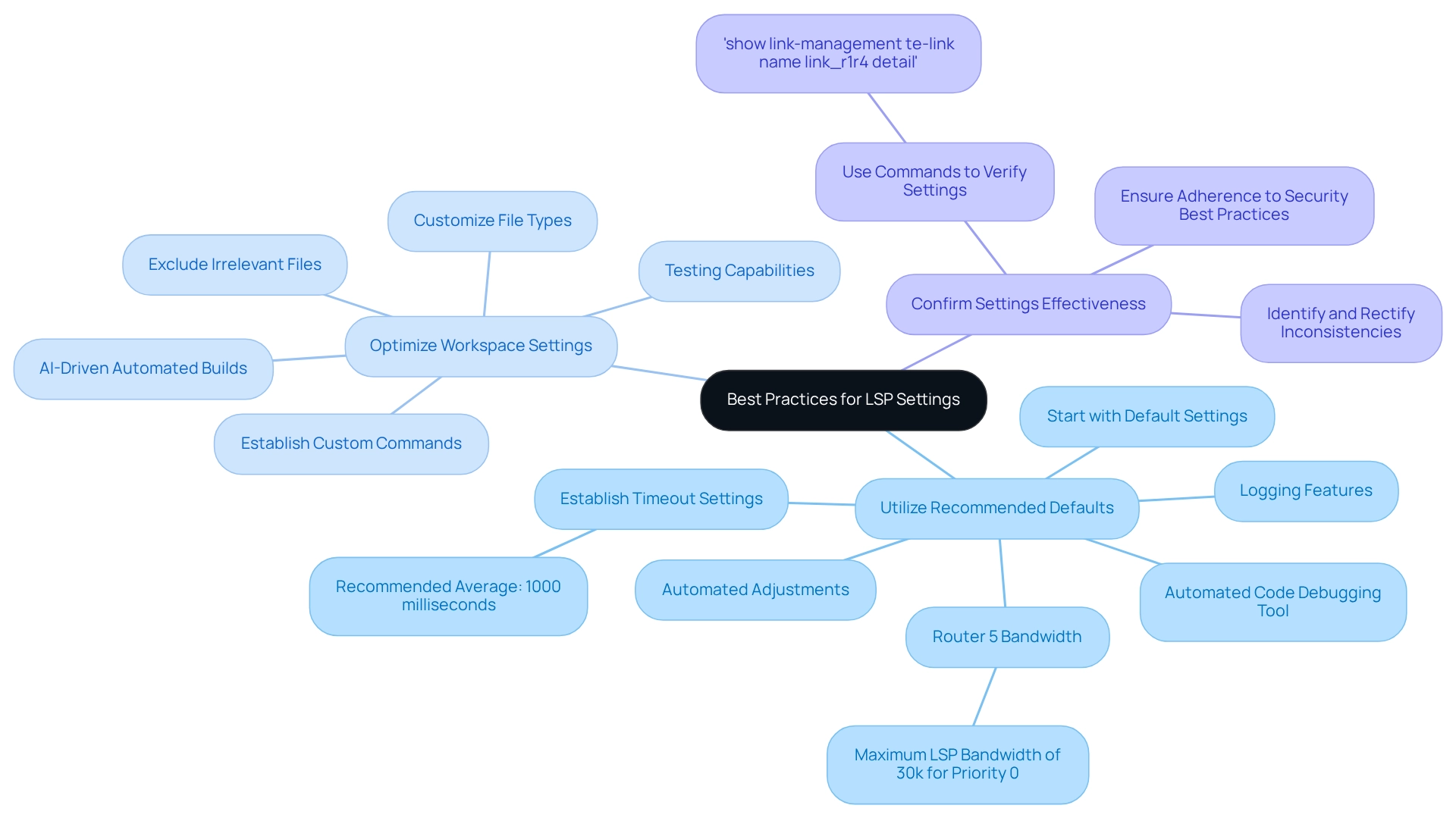Overview
The article highlights three essential practices for effective Language Server Protocol (LSP) configuration. Developers often encounter challenges in maintaining consistency, simplicity, documentation, and modularity in their coding environments.
How can these practices help? By emphasizing these elements, the article demonstrates how they enhance productivity and reduce complexity. Furthermore, these practices facilitate better team collaboration, ultimately leading to more efficient software development processes.
Adopting these practices can significantly improve your coding experience and outcomes.
Introduction
In the realm of software development, developers often face significant challenges that can hinder their productivity and efficiency. The Language Server Protocol (LSP) has emerged as a pivotal tool to address these issues, streamlining communication between code editors and language servers. However, configuring LSP effectively requires more than just technical knowledge; it demands a strategic approach rooted in core principles that enhance productivity and minimize complications. By focusing on consistency, simplicity, documentation, and modularity, developers can create a robust framework that supports efficient workflows.
Furthermore, implementing best practices and integrating automated testing not only optimizes configurations but also ensures reliability in dynamic environments. This article delves into essential strategies for establishing effective LSP configurations, empowering developers to elevate their coding practices and achieve greater success in their projects. Are you ready to explore how Kodezi can transform your coding experience and help you overcome these challenges?
Establish Core Principles of LSP Configuration
To effectively configure the lsp config, programmers should establish core principles that guide their setup. These principles include consistency, simplicity, documentation, and modularity, all of which play a crucial role in enhancing the development process.
- Consistency is key. Keeping uniform setups across various projects reduces cognitive load and simplifies the development process, enabling developers to concentrate on coding instead of adapting to different arrangements. As Geosley Andrades observes, consistent arrangements strengthen the code's structure, improving readability, maintainability, and testability. Moreover, uniform setups aid in automated code troubleshooting, allowing swift detection and resolution of problems, which is vital in agile development settings. Kodezi's automated debugging tools can help fix performance bottlenecks and ensure security compliance, reinforcing the importance of consistency.
- Simplicity is another vital principle. Aim for clarity in setups to avoid unnecessary complexity that can lead to confusion and errors. An intuitive and easy-to-navigate setup is essential. Streamlined setups facilitate automated testing procedures, making it easier to integrate with release cycles and uphold high code quality. Kodezi's tools enhance this simplicity by providing straightforward debugging solutions that streamline the development workflow.
- Documentation is crucial for successful setups. Comprehensive documentation of setup options and their purposes not only aids in onboarding new team members but also serves as a valuable reference for future adjustments. This practice enhances team collaboration and knowledge sharing. Prioritizing documentation can help teams navigate unexpected challenges and unfamiliar projects more effectively, as highlighted in the case study "Documentation as a Strategic Asset." Moreover, thoroughly recorded setups can enhance the synchronization of API documentation and OpenAPI specifications, further improving codebase management.
- Modularity in design is essential. Structures should be modular, allowing simple updates and modifications without interrupting the entire setup. This flexibility enables teams to adapt quickly to evolving project requirements. Furthermore, modular setups can improve automated code evaluations and troubleshooting procedures, ensuring that performance enhancement and security adherence are upheld without considerable burden. Kodezi's tools enhance modularity by enabling programmers to make adjustments effectively while upholding high standards of code quality.
By following these principles, programmers can establish a strong lsp config that enhances productivity and minimizes issues during development, ultimately leading to more effective software projects.

Implement Best Practices for LSP Settings
Developers often face significant challenges in optimizing their lsp config. To address these issues effectively, Kodezi offers advanced features that can streamline the process. By embracing the following best practices, developers can enhance their lsp config efficiently.
Utilize Recommended Defaults: Start with the default settings outlined in the lsp config documentation. These defaults are typically optimized for general use, providing a reliable foundation for setup. For example, Router 5's interface has a maximum LSP bandwidth of 30k for priority 0, underscoring the need to consider bandwidth in your configuration. The tool can further assist by automatically adjusting these settings based on your codebase's specific requirements, especially with the lsp config to ensure prompt LSP responses and minimize delays during development. A common strategy is to establish a timeout that balances responsiveness with server load, with average settings often recommended around 1000 milliseconds. Additionally, the automated code debugging tool can help detect and resolve timeout-related issues swiftly, enhancing overall performance, and enabling logging features allows you to track lsp config interactions effectively. This practice helps identify issues and refine configurations over time by providing insights into performance bottlenecks. Tools available can streamline this process by automating code evaluations and documentation, ensuring that logs remain thorough and practical.
Optimize Workspace Settings: Customizing workspace settings to meet project-specific requirements is essential. This includes configuring file types, excluding irrelevant files from analysis, and establishing custom commands that boost productivity. Kodezi’s AI-driven automated builds and testing capabilities support these optimizations, ensuring compliance with the latest standards and facilitating easier adaptation to various coding environments.
Confirm Settings Effectiveness: To verify the state and bandwidth of your lsp config settings, utilize commands such as [show link-management te-link name link_r1r4 detail](https://juniper.net/documentation/us/en/software/junos/mpls/topics/topic-map/rsvp-configuration.html). This real-world application ensures that your settings function as intended. With Kodezi's capabilities, programmers can quickly identify and rectify inconsistencies, ensuring adherence to security best practices and coding standards. By applying these best practices and leveraging Kodezi's robust features, programmers can significantly enhance the efficiency and effectiveness of their lsp config setups. This ultimately leads to increased productivity and streamlined workflows. Are you ready to explore the tools available on the platform to elevate your coding experience?

Integrate Automated Testing for LSP Configurations
To navigate the complexities of coding, developers must ensure the reliability of their lsp config by integrating automated testing into their workflows. How can this be achieved effectively? Here are several strategies that can enhance your development process:
- Unit Testing: Begin by creating unit tests for the separate components of the lsp config setup. This practice verifies that each part functions correctly in isolation, significantly reducing the overall cost of a project. As noted, "Using good unit testing tools means you reduce the overall cost of a project."
- Integration Testing: Implement integration tests to confirm that the integration with the lsp config interacts correctly with other tools and components in the development environment. This method assists in identifying problems that emerge from alterations in dependencies or setups.
- Continuous Integration (CI): Leverage CI tools to automate the testing process. Set up pipelines that execute tests whenever modifications are made to the lsp config, ensuring that any problems are detected early in the development cycle.
- Performance Monitoring: Regularly monitor the performance of the LSP setup using automated tools. This practice aids in recognizing slowdowns or bottlenecks that may arise from changes in setup. For instance, the case study on "Thread Safety and Dependency Injection" highlights the importance of ensuring thread safety in static classes before applying dependency injection, as failing to do so can lead to significant issues in multi-threaded environments.
By adopting these automated testing strategies, developers can maintain a high level of confidence in their lsp config, which leads to a more stable and efficient development process. Current trends indicate that practitioners are increasingly utilizing standard best practices to enhance test automation maturity, which is crucial for effective lsp config.
Conclusion
Establishing effective configurations for the Language Server Protocol (LSP) is crucial for enhancing developer productivity and streamlining workflows. Developers often face challenges in navigating complex coding environments. How can these challenges be addressed? By adhering to core principles such as consistency, simplicity, documentation, and modularity, developers can create a robust framework that minimizes complications. These principles not only facilitate better collaboration but also foster an environment where automated debugging and testing thrive, ultimately leading to improved code quality and maintainability.
Furthermore, implementing best practices, such as utilizing recommended defaults and optimizing workspace settings, further bolsters the efficacy of LSP configurations. By embracing these strategies and leveraging tools like Kodezi, developers can ensure that their setups are responsive, efficient, and tailored to specific project needs. The integration of automated testing into the development process is equally crucial, as it provides a safety net that helps identify issues early and maintains the integrity of the codebase.
In addition, mastering LSP configurations through strategic approaches and best practices equips developers with the tools necessary to navigate the complexities of modern software development. By prioritizing these methodologies, developers can overcome common challenges and elevate their coding practices. What if you could achieve greater success in your projects? Embracing this transformative journey with Kodezi can lead to a more efficient and rewarding coding experience. Explore the tools available on the platform and unlock your full coding potential.
Frequently Asked Questions
What are the core principles for configuring the lsp config?
The core principles for configuring the lsp config include consistency, simplicity, documentation, and modularity.
Why is consistency important in lsp configuration?
Consistency is important because it reduces cognitive load and simplifies the development process, allowing developers to focus on coding. It also strengthens the code's structure, improving readability, maintainability, and testability, while aiding in automated code troubleshooting.
How does simplicity contribute to effective lsp configuration?
Simplicity contributes to effective lsp configuration by promoting clarity and avoiding unnecessary complexity, which can lead to confusion and errors. An intuitive setup facilitates automated testing and helps maintain high code quality.
What role does documentation play in lsp configuration?
Documentation is crucial as it provides comprehensive details about setup options and their purposes, aiding in onboarding, team collaboration, and knowledge sharing. It also helps teams navigate challenges and improves synchronization of API documentation.
What is the significance of modularity in lsp configuration?
Modularity is significant because it allows for simple updates and modifications without disrupting the entire setup. This flexibility helps teams quickly adapt to changing project requirements and enhances automated code evaluations and troubleshooting.
How can following these principles benefit programmers?
Following these principles can help programmers establish a strong lsp config that enhances productivity, minimizes issues during development, and leads to more effective software projects.




